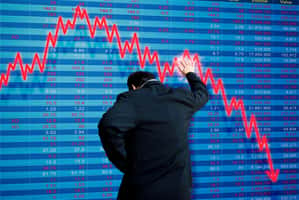We are seeing remarkable strength across the commodity complex. Many commodities are hitting fresh all-time highs like copper, iron ore, and lumber, while others, including agricultural commodities, are making multi year highs. This includes corn, which just hit a seven-year high earlier this week, reaching $6.50 per bushel.
In recent days, corn prices have backed off about 6% as markets digest these gains amid a risk-off environment. However, on a longer-term basis, the fundamentals remain strong, due to increased demand and supply constraints. As a result, investors should consider buying stocks that will profit from the surge in corn prices such as Archer Daniels Midland (ADM), Mosaic (MOS), and Bunge Ltd. (BG).
Supply and Demand Dynamics
The supply and demand picture for corn, like many commodities, is shaped by two factors: its bear market from 2013 to 2020 and the coronavirus.
Bear Market
This 16 year chart of corn prices shows corn’s steep decline from 2013 to 2015 and then 5 years of sideways trading at lower prices.
This period of low prices led to bleak conditions for farmers, with many bankruptcies and forced farm sales. It also led many to prioritize cost-cutting and caution. This behavior has been ingrained as intentions for plantings this year show only a 1% increase despite much higher prices.
This probably means that prices need to go higher before supply increases. Contrast this to previous peaks in corn prices when production on a year over year level would be 7 to 10% higher.
Coronavirus
Another major factor has been the coronavirus and its subsequent impacts on the supply and demand side.
Supply has been negatively impacted across all areas including food production. For example, it became tougher for workers to travel to farms for work. Companies also became intensely focused on cutting costs and preserving cash as they assumed that demand would drop.
However, demand has remained very strong contrary to expectations. In fact, consumer spending is at record highs, and household balance sheets are in good shape in part due to stimulus payments and the Fed’s largesse. Of course, another important factor is that the economy turned out to be more resilient and adaptable than expected.
Most corn is used for animal feed. So, corn prices tend to go lower during periods of weak economic growth as does meat consumption, especially in the developing world. Therefore, many corn farmers made a sensible decision in making conservative planting and spending decisions.
In essence, they prepared for a downturn that never came and remained in a defensive crouch which is exacerbating the squeeze in the market.
3 Stocks to Consider
Farmers will certainly benefit from these conditions, as will certain agriculture (ag) companies.
Investors should look at companies in the sector with pricing power and whose stocks show potential for earnings per share (EPS) growth and multiple expansion. Historically, rising margins, earnings growth, and multiple expansion is the recipe for big gains in cyclical stocks.
Here are 3 stocks with such potential:
Archer Daniels Midland (ADM)
ADM is one of the four largest ag companies in the world and was founded in 1902. It procures, processes, and sells agricultural commodities, products, and ingredients in the US and worldwide. It also offers financial services to farmers and ag companies. It also produces and sells many end-products such as grain, oilseed, and biofuels.
The company has topped earnings expectations for four straight quarters, and it’s outperformed in 2021 with a 31% gain. It also expects 25% EPS growth which gives it a very reasonable forward PE of 15.2. Wall Street analysts are also bullish on the stock as 8 out of 11 analysts covering the stock have a Buy rating. They’ve also been hiking 2021 and 2022 EPS estimates by double-digits in recent months.
Given this combination of value and growth, it’s not surprising that ADM is rated an A by the POWR Ratings which equates to a Strong Buy. A-rated stocks have an annual performance rating of 30.7% which compares favorably to the S&P 500’s 7.3% gain.
The POWR Ratings also evaluates stocks by components to give more insight. In terms of Growth, ADM is rated a B. This fits with its bullish earnings outlook, analysts upgrading EPS estimates, and the favorable conditions for ag prices. To see more of ADM’s component grades including Value, Stability, Sentiment, Momentum, Quality, and Industry, click here.
Bunge Ltd. (BG)
BG is also one of the four largest agricultural companies in the world and has a large presence in Brazil.
BG has been around since 1818 and is a leading biofuel producer.
BG has done very well over the past year due to rising prices. The company has topped analysts’ expectations over the past 4 quarters. This has resulted in analysts’ expectations increasing by 60% for 2021 over the past few months.
BG remains off its 2008 high of $135 even though it was earning $12.50 in EPS at that time. Today, its EPS on a trailing 12-month basis is $14.70. One potential factor is the company’s exposure to the Brazilian real which has been quite weak.
BG has an overall grade of B or a Buy rating in our POWR Ratings service. The company also has a Value grade of B, which isn’t surprising given its PE of 6 and a forward PE of 12. Both are significantly cheaper than the market.
To see BG’s other grades including Growth, Industry, Momentum, Stability, Sentiment, and Quality, please click here.
Mosaic (MOS)
MOS is one of the largest fertilizer companies in the world. Fertilizer prices are also moving higher with food prices. There has been underinvestment in phosphate and potash production as well while demand has been resilient.
Over the last year, EPS estimates for 2021 and 2022 increased from $0.50 and $0.65 to $2.50 and $3.10, respectively due to strong gains in fertilizer prices. The weakness in ag from 2013 to 2020 led to many fertilizer companies going bankrupt. Companies like MOS increased market share.
Thus, the stock could have more upside especially as its multiples are so low. Currently, it has a PE of 13 which is significantly cheaper than the S&P 500. The company also has hefty profit margins at 11% which will only increase if prices continue to rise. It also remains well off 2008 and 2011 levels despite similar earnings.
This upside is reflected in MOS’ POWR Ratings as it has an overall grade of B, which translates into a Buy. MOS has a Value grade of B which is consistent with its PE which is well below the market average. Further, the S&P 500 has a forward PE of 23, while MOS has a forward PE of 14.5. This gives the stock more cushion in the case of downside and more upside if sustained earnings growth leads to multiple expansion.
Discover Today’s Best Growth Stocks
This article was written by Jaimini Desai, Chief Growth Strategist for StockNews.com. Jaimini has been dialed into the hottest trends in investing:
- Electric Vehicles
- 5G
- Internet of Things
- Cloud Computing
- Genomics
- And Much More
If you would like to see more of his best growth stock ideas, then click the link below.
BG shares were unchanged in after-hours trading Thursday. Year-to-date, BG has gained 37.08%, versus a 10.10% rise in the benchmark S&P 500 index during the same period.
About the Author: Jaimini Desai

Jaimini Desai has been a financial writer and reporter for nearly a decade. His goal is to help readers identify risks and opportunities in the markets. He is the Chief Growth Strategist for StockNews.com and the editor of the POWR Growth and POWR Stocks Under $10 newsletters. Learn more about Jaimini’s background, along with links to his most recent articles. More...
More Resources for the Stocks in this Article
| Ticker | POWR Rating | Industry Rank | Rank in Industry |
| BG | Get Rating | Get Rating | Get Rating |
| ADM | Get Rating | Get Rating | Get Rating |
| MOS | Get Rating | Get Rating | Get Rating |





